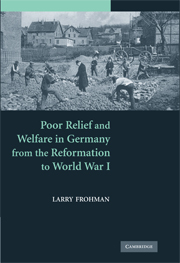Book contents
- Frontmatter
- Contents
- List of Tables and Figure
- Acknowledgments
- Introduction
- 1 Discipline, Community, and the Sixteenth-Century Origins of Modern Poor Relief
- 2 The Rise and Fall of the Workhouse: Poor Relief in the Age of Absolutism
- 3 Pauperism, Moral Reform, and Visions of Civil Society, 1800–1870
- 4 The State, the Market, and the Organization of Poor Relief, 1830–1870
- 5 The Assistantial Double Helix: Poor Relief, Social Insurance, and the Political Economy of Poor Law Reform
- 6 New Voices: Citizenship, Social Reform, and the Origins of Modern Social Work in Imperial Germany
- 7 The Social Perspective on Poverty and the Origins of Modern Social Welfare
- 8 From Fault to Risk: Changing Strategies of Assistance to the Jobless in Imperial Germany
- 9 Youth Welfare and the Political Alchemy of Juvenile Justice
- 10 The Social Evolution of Poor Relief, the Crisis of Voluntarism, and the Limits of Progressive Social Reform
- 11 Family, Welfare, and (Dis)order on the Home Front
- 12 Wartime Youth Welfare and the Progressive Refiguring of the Social Contract
- Conclusion: The End of Poor Relief and the Invention of Welfare
- Sources and Abbreviations
- Index
- References
4 - The State, the Market, and the Organization of Poor Relief, 1830–1870
Published online by Cambridge University Press: 17 July 2009
- Frontmatter
- Contents
- List of Tables and Figure
- Acknowledgments
- Introduction
- 1 Discipline, Community, and the Sixteenth-Century Origins of Modern Poor Relief
- 2 The Rise and Fall of the Workhouse: Poor Relief in the Age of Absolutism
- 3 Pauperism, Moral Reform, and Visions of Civil Society, 1800–1870
- 4 The State, the Market, and the Organization of Poor Relief, 1830–1870
- 5 The Assistantial Double Helix: Poor Relief, Social Insurance, and the Political Economy of Poor Law Reform
- 6 New Voices: Citizenship, Social Reform, and the Origins of Modern Social Work in Imperial Germany
- 7 The Social Perspective on Poverty and the Origins of Modern Social Welfare
- 8 From Fault to Risk: Changing Strategies of Assistance to the Jobless in Imperial Germany
- 9 Youth Welfare and the Political Alchemy of Juvenile Justice
- 10 The Social Evolution of Poor Relief, the Crisis of Voluntarism, and the Limits of Progressive Social Reform
- 11 Family, Welfare, and (Dis)order on the Home Front
- 12 Wartime Youth Welfare and the Progressive Refiguring of the Social Contract
- Conclusion: The End of Poor Relief and the Invention of Welfare
- Sources and Abbreviations
- Index
- References
Summary
The reform legislation of the Napoleonic era abolished personal servitude and established the freedoms of occupation, movement, and marriage. In the medium run, though, this proved to be a mixed blessing for the lower classes because the socio-economic forces unleashed by these new freedoms deprived these persons of the social security provided by families, guilds, and lords at the same time that the crisis of pauperism was heightening their need for such protection. While the deepening social crisis provided the stimulus for the growth of moral reform associations, the sheer scope of material distress made it inevitable that poor relief would also have to be restructured in order to respond more effectively to the new forms of social insecurity associated with these personal freedoms. In this respect, the reform of poor relief in the Germanies from the 1830s to the founding of the empire represents the capstone of the reform legislation of the Napoleonic era.
Despite their common interest in consolidating control over newly acquired territories and forging a unified, territorial economic and political space, Prussia and the southern states ultimately adopted diametrically opposed approaches to poor law reform. While the right to determine the conditions under which an individual could become a local citizen, reside in the town, marry, exercise a trade, and receive public assistance had long been both symbol and substance of the corporate liberty of the cities, during these decades the newly consolidated territorial states were also trying to assert their internal sovereignty against the resistance of the remaining corporate bodies, and settlement and poor relief legislation were two of the key sites of conflict in this struggle between the local and territorial states.
- Type
- Chapter
- Information
- Publisher: Cambridge University PressPrint publication year: 2008



